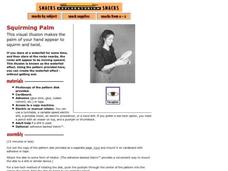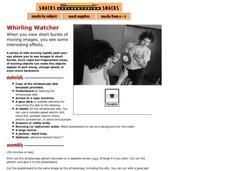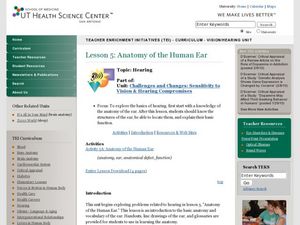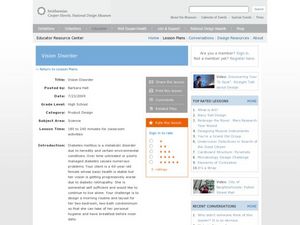Exploratorium
Disappearing Act
Crafty critters are camouflaged to escape predators, and crafty science pupils can construct a camouflage demonstration. They work with a partner to show that as a camouflaged animal moves, it becomes more visible.
Exploratorium
Jacques Cousteau in Seashells
Visionaries create images out of dots to demonstrate the eye-brain connection. Through this activity, they learn that the brain interprets data collected by the eye into recognizable information. Search online for "Jacques Cousteau in...
Exploratorium
Blind Spot
A small card with a dot and an X is held at arm's length and used to show youngsters where their blind spot is. This illuminating little activity is a compact addition to your lesson on the structure of the eye as it explains the part of...
Exploratorium
Thread the Needle
If you are setting up a rotation lab where learners are investigating vision at different stations, this activity can be used to explore depth perception. Setting up a giant needle eye, students attempt to pass a pencil through it with...
Exploratorium
Squirming Palm
You will need an electric drill and some Velcro™ in order to have this activity available for your class. It is, however, an intriguing display of optical illusion. After watching a spinning disk (provided), viewers look at one of their...
Exploratorium
Seeing Your Blind Spot
Viewers use a small, dimmed flashlight to identify the blind spot for both the right and left eye. It is a simple activity to incorporate into your activities during a lesson on vision and the structure and function of the eyeball.
Exploratorium
Seeing Your Retina
Using a dimmed flashlight, life science learners can see the network of blood vessels that line the back of their eye. Darken the room and let them try this activity as part of your unit on the eyeball. Also consider some of the other...
Exploratorium
Cheshire Cat
Divide your field of vision in two and see what happens when your two eyes behold two different scenes! This is a way to demonstrate to body-systems buffs how the two eyes usually blend pictures to create a three-dimensional view. This...
Exploratorium
Whirling Watcher
Pupils put together their own stroboscopes so that they can observe how cyclically moving images appear to merge into a singular object. This, and several other activities published by the same source, illuminate the way the brain...
Exploratorium
Far Out Corners
Construct a three-dimensional optical illusion when your class is exploring vision and how the eye and brain work together. Three concave corners are mounted inside of a black box, but as a light is shined upon them, they appear to be...
Exploratorium
Fading Dot
Fuzzy edges cause an image to fade from view in an activity intended to demonstrate how vision works.
Exploratorium
Depth Spinner
Put a new twist on your collection of optical illusion activities. Affix the linked printable spiral to a drill, record player, or some other rotating tool. Have learners stare at the spinning disk for only 15 seconds and then look away....
Exploratorium
Cardboard Tube Syllabus
Construct paper tubes and then try out a few optical illusion tricks:
See a virtual hole in your own hand
Get a grasp of how the eyes combine images
Notice that one eye is dominant over the other
Reveal how your eyes adjust to...
Curated OER
Studying our Senses
Who would not want an opportunity to taste jellybeans in class? During this investigation, life science learners hold their noses as they take a taste test and find that our perception of flavor is connected with our sense of smell. In...
Curated OER
Light, Colors, and Vision
Third graders experience optic illusions by creating flipbooks. In this optics lesson, 3rd graders view a demonstration of the workings of rods and cones using a camera. They are shown an optical illusion and work to create their own...
Curated OER
The Eyes Have It!
Reading essays about deep-sea expeditions open this instructional activity on crustacean vision. Marine biology explorers study the compound eye and then complete a worksheet in response to all they have discovered. Although the...
Curated OER
Now You See Me, Now You Don't
Bioluminescence fascinates most upper elementary scientists. Display images of different glowing deep-sea organisms and discuss their environment. Young biologists then experiment with images and different colors of filtered light. In...
Curated OER
What Role Does Light Play Within the Vision Process?
Students are introduced to the relationship between light and vision. In groups, they participate in experiments to discover how different wavelengths are divided in the visible spectrum. They record their answers and discuss their...
Curated OER
Blind as a Bat?
Imagine using your ears and voice to see. That is what bats do with echolocation. Demonstrate how echolocation works with this fun game for your classroom. Buzz, buzz!
Curated OER
Anatomy of the Human Ear
Students examine the human ear and its function. In this anatomy of the human ear lesson plan, students view drawings of the ear and learn about the structure of the ear through handouts and glossaries. This lesson plan is part of a...
Curated OER
Arthur's Eyes
Students learn about the parts of the eye. For this eyes and vision lesson, students the story Arthur's Eyes and create a KWL chart about eyes. Students label the parts of the eye, examine the eyes of different animals to compare them...
Curated OER
20/20 Vision
Learners determine their own eyesight and calculate what a good average eyesight value for the class would be. They examine how technology enhances eyesight and how engineers play an important role in the development of these technologies.
Curated OER
Vision Of The Future
Students investigate ways in which new vision tests and technologies can be used to help detect and correct vision problems. They begin by reading the Times article, Software May Replace the Eye Chart on the Wall. They stage a medical...
Curated OER
Vision Disorder
Learners design a morning routine for a 60 year old female senior with vision disorder. In this biology lesson, students collaborate with their team to come up with possible solutions. They present at least two ideas of their design to...

























